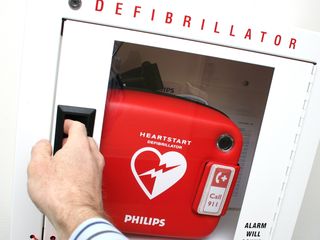 You’re in the Chicago airport, hustling from your Portland flight to your next leg. As you zigzag in between travelers on the concourse, you pass an older woman who appears to stumble and then drop to the ground. At first you think you somehow knocked her down accidentally. She appears unresponsive. A small crowd gathers as someone murmurs they’ve already called 911. What next?
You’re in the Chicago airport, hustling from your Portland flight to your next leg. As you zigzag in between travelers on the concourse, you pass an older woman who appears to stumble and then drop to the ground. At first you think you somehow knocked her down accidentally. She appears unresponsive. A small crowd gathers as someone murmurs they’ve already called 911. What next?
In the old days — before the time of portable, on-site defibrillators known as AEDs — non-medical bystanders or “lay rescuers” were taught to begin CPR and rescue breathing, even if there was no one available to call 911. Now the recommendation is to call 911 first, and if available, to obtain and use an AED before any CPR is initiated.
AEDs were deployed into public places in the US after a favorable study in Chicago’s O’Hare and Midway airports in 1999. Researchers placed defibrillators in well-marked locations on concourses, within a one-minute walk of each other. The goal was to be able to defibrillate a victim within a couple minutes, when survival can be as high as 90 percent. (Unfortunately, survival declines by 7 to 10 percent for every minute that passes without defibrillation.)
Within 10 months of installation, AEDs had been used in 14 cardiac arrests, with a startling 9 of 14 victims (64 percent) surviving. These results were replicated in a similar study in casinos in 2000, with 56 of 105 patients (53 percent) surviving to hospital discharge. To put this in context, typical out-of-hospital arrests survive less than 10% of the time.
You can now find defibrillators in most large public spaces. The state of Oregon has passed a new law that requires AEDs in buildings of 50,000 SF or more. Heck, there’s even an iPhone app to find the nearest defibrillator.
But are people willing to use them on a stranger? Sadly, the answer often is “no.” A new paper published in the Annals of Emergency Medicine surveyed over 1,000 people passing through the central rail station in Amsterdam, which gets about 250,000 visitors daily. Less than half of those surveyed said they would use a defibrillator on a fellow traveler. Reasons for their reluctance included not knowing how to use the device, and fear of harming the victim.
More than half of interviewees were unable to even recognize what an AED looks like. Most concerning to public health professionals: only six percent of study participants thought to mention defibrillation as a first step in the resuscitation of a patient in cardiac arrest.
You can teach yourself to use one of these extremely easy-to-operate devices in a matter of minutes. With up to 325,000 out-of-hospital cardiac arrests in this country each year, you just might get an opportunity to save a life.
